Samsung Gear VR vs Google Daydream View: Which should you buy?
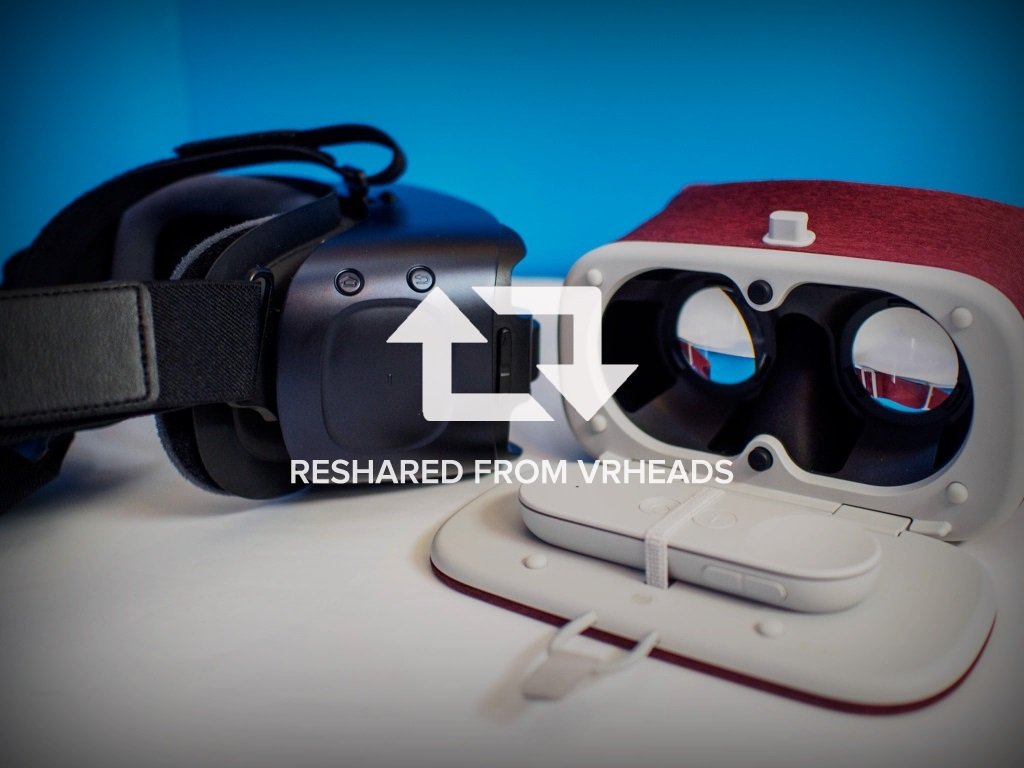
Discovering that your phone can act as the brain for a VR headset is pretty great. You drop the phone into a headset, strap that headset to your face, and suddenly you have access to hundreds of apps and videos all uniquely built for virtual reality. Transforming your phone into a pocket theater on the Moon, an arcade full of unique games, and a portal to see just about every part of the world as though you're actually standing there is both incredible and surprisingly affordable.
If your current phone doesn't support the best VR experiences available right now, there's a good chance your next phone will. The big question you need to answer for yourself is which VR platform you want to be a part of, the Oculus-powered experiences in the Samsung Gear VR or the Google-built platform inside Daydream View. It's not an easy question to answer, but here's everything you need to know about making this decision!
Hardware: Function vs Form
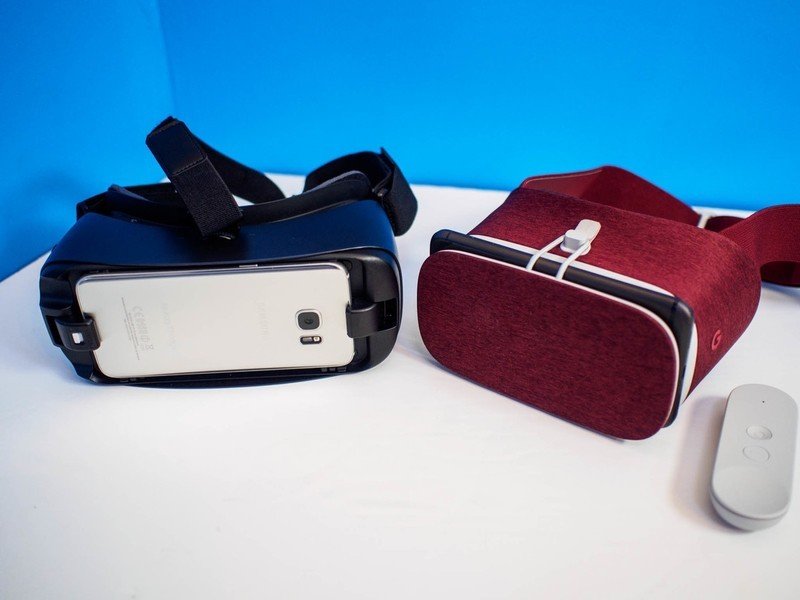
Both Daydream View and Gear VR function with the same basic idea — put your phone here, and attach the other side to your head. There's a pair of lenses inside each headset that warp the images on the phone to fill your field of view, and the motion sensors inside the phone detect your movement and adjust the image on the screen accordingly. Basically, when you turn, the image turns with you and creates a more realistic illusion.
While neither headset is particularly "stylish", especially when you see someone wearing it, Daydream View is noticeably more portable.
But Google and Samsung approach how most of this works from very different perspectives. Samsung includes extra motion-sensing hardware in the Gear VR and includes a USB port for you to connect your phone to when you place it in the headset. Google relies on the sensors inside the phone itself, but uses higher quality sensors to better detect motion without needing extra hardware. In most apps it's nearly impossible to tell the difference between the two implementations, and for Google that's a good thing. It means Google can use many different phones from many different manufacturers inside Daydream View, where the Gear VR chooses to only use high end Samsung phones that fit in the casing.
Google's hardware decision with Daydream View also means there's no need to connect anything to the phone, which means the headset itself can be physically smaller than Samsung's Gear VR. It also means there's little need for rigid plastics to hold those ports in place, so Google wrapped the inside and outside of Daydream View in fabric. While neither headset is particularly "stylish", especially when you see someone wearing it, Daydream View is noticeably more portable due to its smaller and plushier exterior.
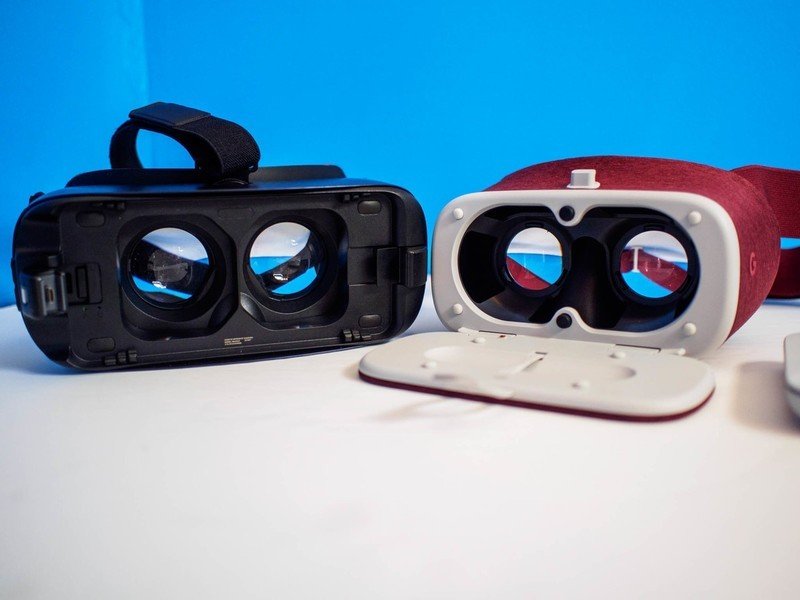
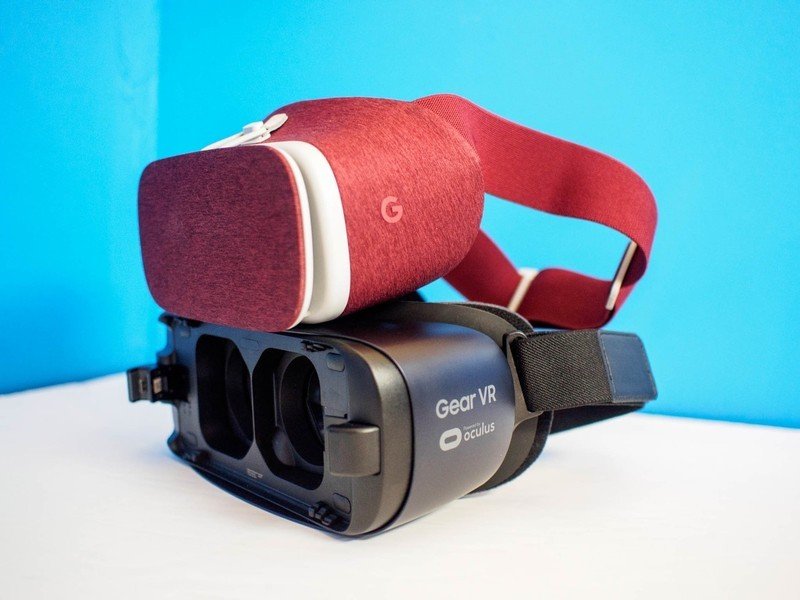
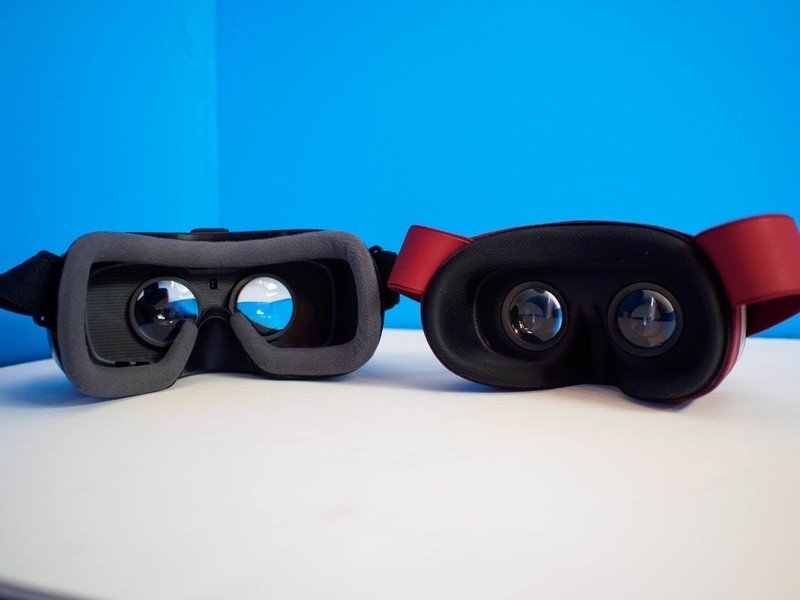
Samsung's trade for portability allows the Gear VR to include a sliding wheel to control how far away the display of the phone is from the lenses. Control over focal depth means many VR owners with prescription glasses can wear the headset without needing to wear them in the headset, which is often a great deal more comfortable than trying to fit your frames into the headset without smudging your lenses. Google's solution to this problem was to make the part of the headset that rests against your head extra wide, so wearing your glasses is more comfortable.
Unfortunately, Google's solution introduces gaps between the padding and your face on the left and right side of the headset. These gaps allow the lenses to breathe a little and can be helpful to reduce fogging, but it also means there's nothing to stop light from entering the headset on both sides of your face. Light in the headset decreases immersion, and in some environments can cause reflections on the lenses that can cause eye strain from rapidly focusing at multiple distances.
Be an expert in 5 minutes
Get the latest news from Android Central, your trusted companion in the world of Android
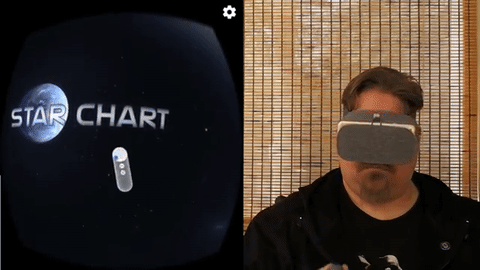
Samsung and Google also use different built-in controls for navigating interfaces and playing games in VR. Samsung includes a touch-capable square on the side of the headset, enabling you to reach up and tap the side of the headset when you want to select something. Many apps and games use swipe actions on this pad for other activities, but for the most part, you look at the specific thing you want to interact with and touch the pad to interact. This isn't always a totally functional option, so Bluetooth Gamepads are either supported or required in some games. Of course back in April of 2017, Samsung also released a small handheld controller to interact with Gear VR's UI. It doesn't replace the touchpad, but does make it easier to interact, and makes certain games far more fun.
The fabric body on Daydream View doesn't allow for a touch interface, so Google includes the Daydream Controller. This Bluetooth wand has a touch area where you rest your thumb, but the controller itself is a part of the VR world. When you raise your arm up, the controller appears in VR and moves as your hand moves. Daydream Controller becomes your pointer for selecting things, your interactive accessory for games, and a way to present additional information closer to your face.
One of the most commonly asked questions with any Mobile VR headset usually has to do with heat. When phones get hot, especially for extended periods of time, problems frequently arise. Outside of being uncomfortable to use or store in your pocket when you come out of VR, extended heat can often be a cause for concern with the overall life of the battery in your phone. It's also important to point out that heat can occasionally cause lenses in VR headsets to fog up with greater frequency or easy. Daydream View can use many different phones, but most of them get quite warm after 15-20 minutes of use. Samsung's Galaxy S7 and Galaxy S7 Edge, on the other hand, are noticeably cooler to the touch after the same amount of time in the headset. Some of this has to do with Samsung exposing the back of its phones to air while in the Gear VR, while Google sandwiches phones between the two pieces of plastic that make up the enclosure space next to the lenses.
Daydream did make some pretty serious upgrades with their release of the 2017 model Daydream View. It comes with a built-in heatsink which means that it is far more capable of keeping your phone cool during extended play sessions. It still isn't perfect, and your phone is going to heat up, but it's a noticeable difference between the newer and older models. It's fabric is also a bit lighter, and softer to the touch. The other big changes includes better control of light leak to ensure that you are completely immersed in VR, and new larger lenses.
Though these two hardware perspectives accomplish many similar goals, there are some clear advantages to each. Samsung Gear VR offers a slightly wider field of view with its lenses. Google Daydream View is both more comfortable and more portable. When comparing the original Daydream View against Gear VR, it falls a bit short. This is primarily due to issues with light leaks, and heat management.
However, with the upgrades to the 2017 model of Daydream View, it pulls ahead of the competition. The built-in heatsink takes care of overheating problems, a better seal eliminates the issues of light leak, and larger lenses create a more immersive experience. With this changes, they've fixed the initial issues, making it the superior headseat.
Software: Equally Walled Gardens

Where Google Cardboard was built so you could launch an app from your drawer and then peer into the headset, more advanced VR platforms put the whole experience inside the headset. You shop for apps in VR, you browse your library in VR, and when you launch an app from your VR library you're already there to enjoy everything. This isolated setup helps VR feel more like a separate experience from your normal phone behaviors, and it makes a big difference in making you feel immersed in this separate world.
Samsung's Gear VR is a collaboration with Oculus, the company responsible for Rift VR on PCs. Where Samsung provides the hardware for the Gear VR, Oculus provides the software. As soon as you connect your phone to the Gear VR, the Oculus environment takes over and you're in their world. The environment looks like a fancy futuristic apartment complete with crackling fireplace off to the side. From here, you shop for apps and games that have been entirely curated by Oculus. There's a separate purchasing system for this separate app store, which means none of the typical Google Play Store rules apply. Apps are managed and delivered by Oculus, payment methods must entered into the Oculus Store separately, and security measures are separate from the rest of your phone. You're trusting Oculus with everything, and so far they've earned that trust.
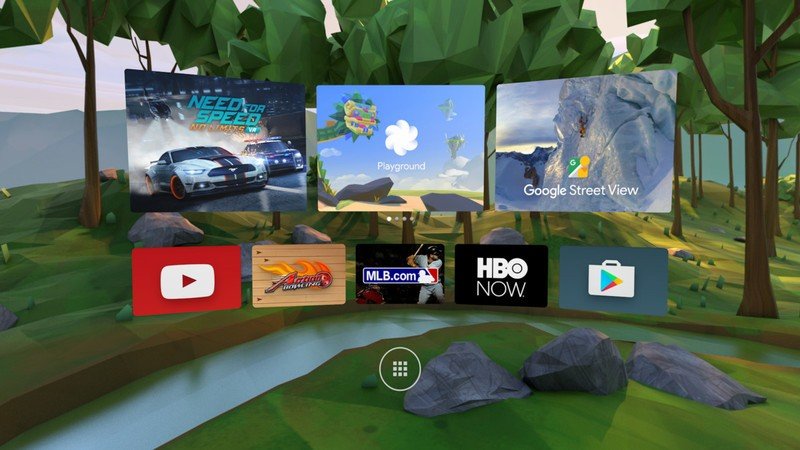
Being a Google Product baked into Android, Daydream is integrated into the Play Store. When you place your phone in Daydream View, an NFC tag launches the VR environment with your library right in front of you. The biggest feature here is the Play Store. Your VR apps can be installed like any other Android app, or they can be installed through the VR app store that only shows you Daydream apps. You're able to redeem Google Play gift cards for VR apps, use Google's family sharing system to pay for apps, and leave reviews like you would any other Android app. Google's security features are baked right in, and work exactly the same as any other Play Store transaction.
Since being acquired by Facebook, Oculus has had a significant push toward social experiences in VR. Gear VR apps were among some of the first to introduce sharing VR experiences like watching movies together in a room with voice chat enabled, and recent pushes have extended this to a full social environment. Your Oculus Friends List includes an Avatar creation lab and Oculus is working to create several VR worlds where you and your friends can get together and chat inside VR. While there's nothing stopping Google or one of their partners from implementing something similar on Daydream, currently nothing like this exists on Google's VR platform.
If you're interested in the future of VR, Oculus seems better prepared to drive experiences rather than just serve them.
For many people, choosing between Gear VR and Daydream View comes down to the list of available apps. Oculus has been working with developers for content on the Gear VR for much longer than Daydream has even been an option, and as a result currently has a larger list of apps games available. A handful of these experiences have been Oculus exclusives for quite a while, but many app developers are starting to port their Gear VR app to Daydream to sell both groups on their offerings. Google has a healthy list of exclusive content as well, including significant names like Google's Play Movies library, YouTube, HBO streaming, and Eve: Gunjack 2. Both Daydream and Gear VR owners can also tweak the settings to allow all of the Google Cardboard apps to play in the respective headsets.
Perhaps more important than the volume of games is the quality of the individual experiences. Every Google Daydream app works with the Daydream Controller, which means many of the games are a great deal more interactive than their Gear VR counterparts. Users can reach out with their arm and cast spells, steer cars, and many other immersive concepts that simply don't exist on the Gear VR. On the other hand, Google's focus on the Daydream Controller means apps like Minecraft that require a traditional gamepad are unlikely to be available on Daydream anytime soon.

Calling either of these experiences "better" leans heavily on how invested you are in Google's ecosystem. If you've been using an Android phone for a long time and are accustomed to the way the Play Store works, Daydream is noticeably more convenient and gives you access to a great deal more video content. It's also important to look at how Oculus and Google approach content. The head start Oculus has had in this space allows for more choices out of the box when compared to Daydream is significant, and the current focus on social VR has the potential to be an incredibly compelling feature Google isn't anywhere near ready to act as a leader for.
If you're looking at individual VR experiences, Google's offering here feels more robust. If you're interested in the future of VR, Oculus seems better prepared to drive experiences rather than just serve them.
So, which is better?
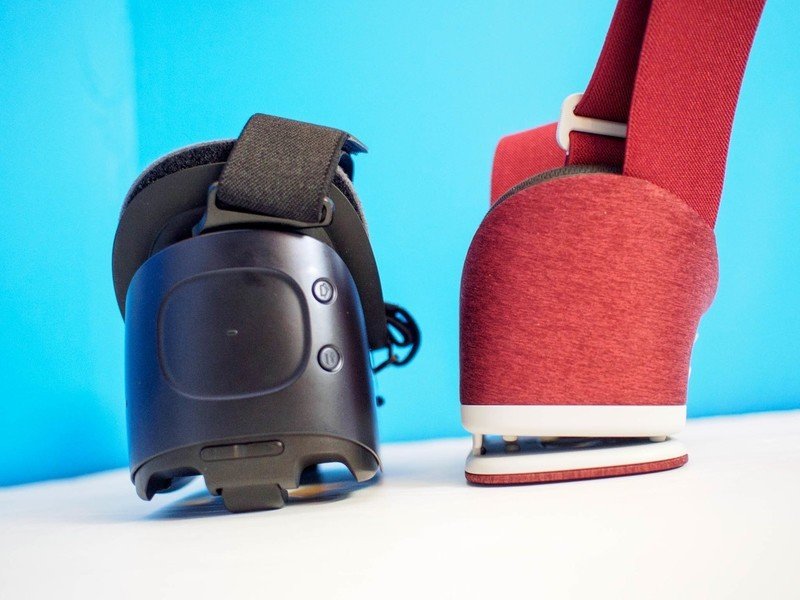
It should be no surprise that both of these headsets and the platform that powers them are excellent. Samsung and Oculus have been carefully polishing the Gear VR for over two years now, and Google's efforts with Cardboard taught the company quite a bit about compelling VR experiences. You truly can't go wrong with either headset right now if you're looking to explore VR and share with friends.
But if you're looking for the platform with the most support with hardware that enables the best overall experiences, the Daydream View and a capableDaydream ready phone to power it is what you should buy right now. Either way you go right now, the next year is going to be full of incredible new VR for you to enjoy.
January 2018: We've updated this post with new information about the 2017 model of Daydream View.

